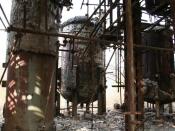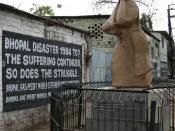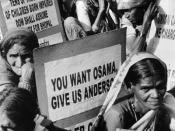In 1984, as if in a very bad dream, a cloud of poison gas reached out and snuffed the lives of thousands of sleeping people in the city of Bhopal, India. The inhabitants awoke to a terrible disaster, a chemical explosion whose memory could very well never be forgotten. At the center of the tragedy was the Union Carbide pesticide plant, and surrounding the accident were doubts and allegations of disregard and unethical practices.
The Union Carbide Disaster
On December 3, 1984, one of the world's worst chemical disasters came about at the Union Carbide pesticide plant in Bhopal, India. 40 tons of vaporous methyl isocyanate (MIC) gas exploded, releasing a toxic mixture of MIC, hydrogen cyanide, monomethyl amine, carbon monoxide, and at least 20 other lethal chemicals into the air. As many as 3,000 people died, and estimates of injuries ranged from 20,000 to 300,000 people (Hedges 2000).
The people of Bhopal referred to it as "The Devils' Night." In the aftermath, there were 70 funeral pyres 25 bodies high, all burning together. Mass graves overflowed, and babies died in hospitals that reported a death occurring every minute. Animal carcasses littered the countryside as well as flies and vultures. Leaves on trees shriveled; crops were seared, milk was ruined and water ways had a filmy layer on the surface. The sounds of wailing, grieving relatives, the moans of those that survived and where in pain, plus hungry children crying was everywhere."(Lang, 1984) This catastrophe was a calamity of proportions beyond measure.
Ethics and the Disaster
Directly after the disaster, accusations arose about U.S. corporations endangering the Third World "in a callous search for profits" (Lang, 1984) Many tried to provide evidence that dangerous chemical plants were being placed in very densely populated areas around the world (Lang, 1984)...


